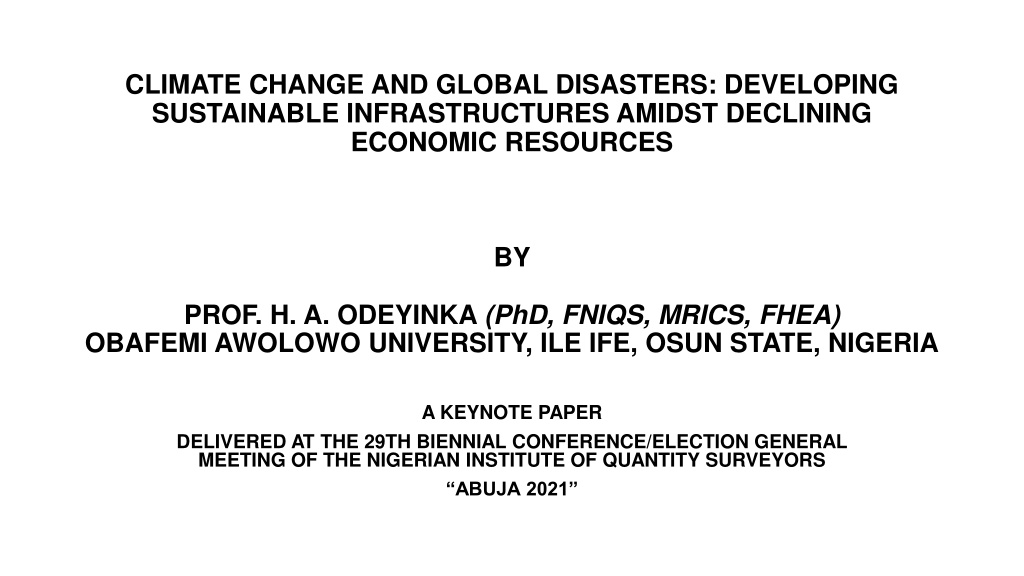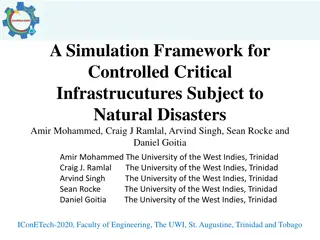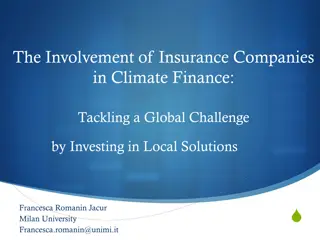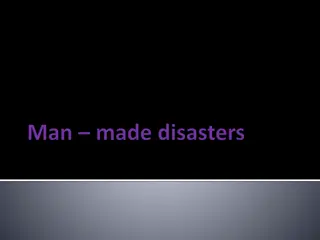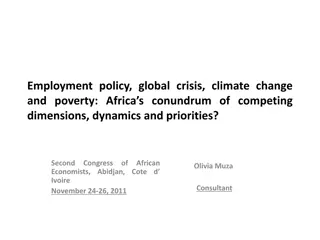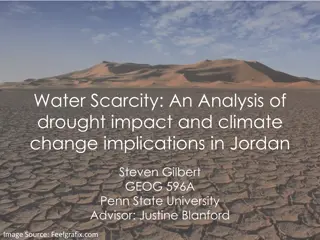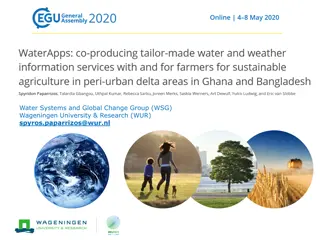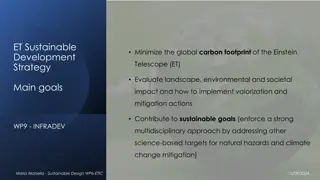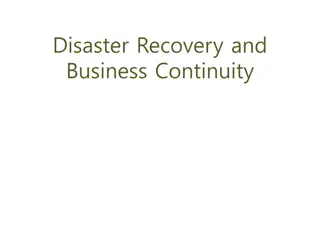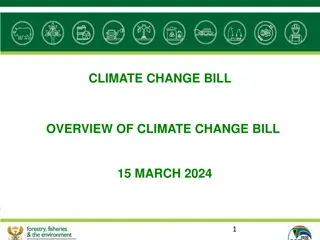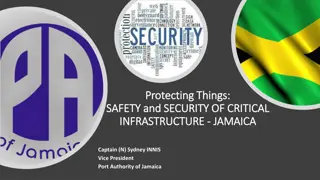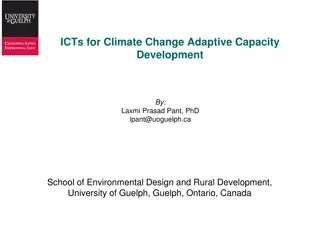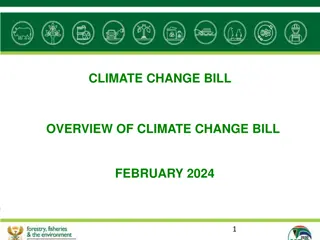Developing Sustainable Infrastructures Amid Climate Change and Global Disasters
Prof. H.A. Odeyinka's keynote paper discusses the importance of developing sustainable infrastructures amidst declining economic resources in the face of climate change and global disasters. It highlights the concepts of climate change, sustainable development, atmospheric layers, ozone layer, carbon emission, and challenges to ozone layer protection. The paper emphasizes the need for addressing carbon emissions, reducing the depletion of the ozone layer, and mitigating the impact of climate change on global ecosystems.
Download Presentation

Please find below an Image/Link to download the presentation.
The content on the website is provided AS IS for your information and personal use only. It may not be sold, licensed, or shared on other websites without obtaining consent from the author. Download presentation by click this link. If you encounter any issues during the download, it is possible that the publisher has removed the file from their server.
E N D
Presentation Transcript
CLIMATE CHANGE AND GLOBAL DISASTERS: DEVELOPING SUSTAINABLE INFRASTRUCTURES AMIDST DECLINING ECONOMIC RESOURCES BY PROF. H. A. ODEYINKA (PhD, FNIQS, MRICS, FHEA) OBAFEMI AWOLOWO UNIVERSITY, ILE IFE, OSUN STATE, NIGERIA A KEYNOTE PAPER DELIVERED AT THE 29TH BIENNIAL CONFERENCE/ELECTION GENERAL MEETING OF THE NIGERIAN INSTITUTE OF QUANTITY SURVEYORS ABUJA 2021
The concept of Climate Change and Sustainable Development Climate change refers to a large-scale, long-term shift in the planet's weather patterns and average temperatures (Meteorological Office UK (Met Office) (2021). Sustainable Development (SD) is a development that meets the needs of the present without compromising meeting the needs of the future generation (WCED, 1987). The need for Sustainable Development Emission, depletion of ozone layer, disaster risk
Atmospheric Layers Atmospheric Layers
Ozone Layer Ozone Layer The ozone layer or ozone shield is a region of Earth's stratosphere that absorbs most of the Sun's ultraviolet radiation. It contains a high concentration of ozone in relation to other parts of the atmosphere, although still small in relation to other gases in the stratosphere.
Carbon emission and depletion of the ozone layer Stratospheric layer shields harmful incoming solar ultraviolet radiation that can damage the ecosystems Atmospheric carbon dioxide and other greenhouse gas (such as Nitrous oxide - N2O, methane - CH4 and others) increased by human and natural processes Increased frequency and magnitude of disasters witnessed in recent past has been attributed to the changes in global climatic conditions due to depletion of ozone layer
Sources of ozone layer depleting substances and challenges to ozone layer protection
Contributory activities several activities across several sectors Buildings and construction sector reportedly accounts for about 36% of global final energy use and about 40% of energy and process-related carbon dioxide (CO2) emissions. The manufacturing of building materials and products accounted for about 11% of this stock (United Nations Environment Programme (UNEP), 2018)
Key Global Disasters MunichRe s account of the number of natural catastrophes 1980 - 2016 (Loss events)
Key UN initiatives addressing Climate Change Brundtland Report (1987) highlighted the three fundamental components of sustainable development, the environment, the economy, and society The Paris Agreement 2015 (Paris Accord) COP21 is a legally binding international treaty on climate change. Its goal is to limit global warming and covers climate change mitigation, adaptation, and finance The 2030 Agenda for Sustainable Development is another intervention with a blueprint for peace and prosperity of the people and the planet. clear targets described 17 Sustainable Development Goals (SDGs) (United Nations, 2015)
Key UN initiatives addressing Climate Change (Contd.) The Sendai Framework for Disaster Risk Reduction (SFDRR) (2015 2030) was initiated to advance Disaster Risk Reduction (DRR) efforts 2021 United Nations Climate Change Conference (COP 26) Glasgow Agreement the rise in the average global temperature is limited to 1.5 degrees Parties are encouraged to strengthen their emissions reductions and to align their national climate action pledges with the Paris Agreement
Country-based interventions UK became the world s first major economy to pass a law committing the country to a target of net zero emissions by 2050 (Met Office, 2021) On 18th March 2021, Nigeria also launched a National Action Plan on Gender and Climate Change (NAPGCC) which aims to ensure that climate actions in Nigeria integrates the contributions of everyone. Beyond the overarching policies, there is the need for country and organisation-specific alignment of principles.
Sustainable Infrastructure Development A Response Strategy to Global Warming The significant contribution of the construction industry to global warming is huge The construction industry also has a lot to contribute to the global response of sustainable infrastructure development quicken human development, mainly in the poorest countries, and to eradicate the gross inequities present in the world today; while at the same time preventing the depletion of the resources and biological systems of the planet to such a degree that future generations would not be impoverished
Commercial office complex (BREEAM, 2020) Examples of Sustainable Infrastructure/Project leading to reduction in carbon emission Commercial office space named Project Mint (Triton Square), London. The project attained post-construction rating of outstanding.
Stairs are centrally located to facilitate walking between floors with a daylight provision and an exemplary view, external terraces are also provided as well as gym and cycle space to promote wellbeing The use of low carbon and efficient technologies such as hybrid air source heat pumps, boilers with 94% efficiency and solar PV achieving 35% reduction in carbon emission Greywater and rainwater harvesting are implemented with a use of low flow sanitary ware that improves water use The key attributes of the project
Choosing refurbishment over demolition thereby reducing about 6000 vehicle movements, 35,000 tonnes of concrete and 2000 tonnes of steel have been reused as well as granite and cladding system. These measures led to embodied carbon savings of 57,000 tonnes equivalent to powering 14,000 homes or driving 150 million miles. 99.9% of waste has been diverted to landfill. The key attributes of the project (Contd.) Innovation on the project A small company was assisted to provide lifecycle assessment data and create an Environmental Product Declaration (EPD) for their product. The EPD is produced based on Life Cycle Assessment (LCA) calculations and provides a quantitative basis for comparison of products and services.
Sustainable Infrastructure Development Sustainable infrastructure is the practice of creating constructed facilities by using best-practice, clean and resource - efficient measures Certification programmes like LEED (Leadership in Energy and Environmental Design) in the United States and BREEAM (Building Research Establishment Environmental Assessment Method) in the UK. The areas of assessment of BREEAM include: 1. Energy 2. Land use and ecology 3. Water 4. Health and wellbeing 5. Pollution 6. Transport 7. Materials 8. Waste 9. Management.
The Implication for the Quantity Surveyor The need to shift focus from costing capital expenditure (CAPEX) of infrastructure project alone to including operating expenditure (OPEX) The need to be knowledgeable in whole life costing so as to enable construction client to choose between traditional construction and sustainable construction. Traditional construction may appear cheater initially but extremely costly when the life cycle cost (Operating expenditure) is factored in as well as the cost of carbon emission (externality).
De-mystifying the High Cost of Sustainable Infrastructure - the UK Example Evidence collected by UK s Building Research Establishment (BRE) and Cyril Sweett (a firm of Chartered Quantity Surveyors) [BRE Trust 2005] Housing Project EcoHome s Good rating can be achieved for an additional capital cost of between 0.3% and 0.9%. Achieving a Very Good rating can be achieved with an additional cost of between 1.3% and 3.1% and an Excellent rating for between 4.2% and 6.9%, for a range of locations.
De-mystifying the High Cost of Sustainable Infrastructure - the UK Example Evidence collected by UK s Building Research Establishment (BRE) and Cyril Sweett (a firm of Chartered Quantity Surveyors) Naturally Ventilated Office A BREEAM Good rating can be achieved for a saving of between 0.3% and 0.4% of the capital cost. A Very Good rating can be achieved for between a cost saving of 0.4% and an additional cost of 2% and an Excellent rating for an additional cost of between 2.5% and 3.4%, for a range of locations.
De-mystifying the High Cost of Sustainable Infrastructure - the UK Example Evidence collected by UK s Building Research Establishment (BRE) and Cyril Sweett (a firm of Chartered Quantity Surveyors) An Air-conditioned Office A BREEAM Good rating can be achieved for an additional cost of between 0% and 0.2% of the capital cost. A Very Good rating can be achieved with an additional cost of between 0.1% and 5.7% and an Excellent rating for between 3.3% and 7.0%, for a range of locations.
De-mystifying the High Cost of Sustainable Infrastructure - the UK Example Evidence collected by UK s Building Research Establishment (BRE) and Cyril Sweett (a firm of Chartered Quantity Surveyors) Private Financed Initiative (PFI) procured health centre project For a Private Financed Initiative (PFI) procured health centre project, the report shows that the base case health centre already achieves a Good rating. A Very Good rating can be achieved at no additional cost and an Excellent rating for an additional cost of between 0.6% and 1.9%, for a range of locations
De-mystifying the High Cost of Sustainable Infrastructure - the UK Example Overall, the report demonstrates that significant improvements in the sustainability performance of a building can be achieved at very little additional cost. The report also demonstrates that more sustainable buildings can offer major life-cycle cost benefits. This implies that whilst the majority of Quantity Surveyors (QS) are versed in the techniques of determining the capital cost of a building, they also need to up skill themselves in determining the life cycle cost and whole life costs of buildings.
Conclusion Themes such as emissions, climate change, disaster risk and interventions aimed at tackling these global challenges have been discussed. It is clear that collective action is required towards reducing the triggers of climate change Operate sustainably to protect the people and our planet. Globally, construction is a major sector, and the role stakeholders play is fundamental to the realisation of sustainable development. There is more to do to help stakeholders embed sustainable principles in their day-to-day activities. Operationalising the concept of sustainable procurement is still germane for our industry
CLOSING Further interesting and insightful discussions are upcoming during this conference. I wish everyone a productive deliberation.
